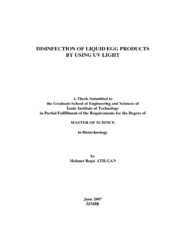Please use this identifier to cite or link to this item:
https://hdl.handle.net/11147/3634| Title: | Disinfection of Liqued Egg Products by Using Uv Light | Authors: | Atılgan, Mehmet Reşat | Advisors: | Ünlütürk, Sevcan | Publisher: | Izmir Institute of Technology | Abstract: | The application of UV treatment to continuous flow of liquid egg products is the initial study among the others. The objective of this study was to investigate the efficiency of UV-C radiation as a non-thermal pasteurization process for liquid egg products (LEPs). The outcomes of this study were evaluated from the rheological, biodosimetric and inactivation efficiency points of view. The results pertaining to rheological characterization, physical and optical measurements of the fresh and pasteurized LEPs indicated that liquid whole egg (LWE) and liquid egg white (LEW) showed Newtonian behavior within the range studied. Liquid egg yolk (LEY) exhibited pseudoplastic and time independent behavior in temperature ranges from 4 C to 25 C. But its rheological behavior was affected at pasteurization temperature and showed thixotropy and time dependent. The biodosimetric study based on the UV treatment of LEPs by using collimated beam apparatus pointed out that the best reduction was achieved in liquid egg white (LEW) when the fluid depth and UV dose were 0.153 cm and 98 mJ/cm2, respectively. Maximum inactivation was 0.675-log CFU/ml in liquid egg yolk (LEY) and 0.316-log CFU/ml in liquid whole egg (LWE). The kinetics of UV inactivation of E.coli in LEPs was found nonlinear. Our results emphasize that UV-C radiation can be used as a pre-treatment process or combined with mild heat treatment to reduce the adverse effects of thermal pasteurization of LEPs. The efficacies of short wave ultraviolet light (UV-C) as a non-thermal process for LEW were investigated in the continuous flow UV reactor based on the result derived from the biodosimetric study. Maximum 0.2 log reduction was achieved after 5 cycle of operation. The efficiency of the UV light treatment in continuous flow UV reactor was found to be lower compared to bench-top studies. This is attributed to the problems caused by inefficient design of UV chamber. Results of these work showed that the UV reactor was designed poorly to supply enough UV irradiation exposure for all the fluid elements in the system. Redesigning of the system was suggested. | Description: | Thesis (Master)--Izmir Institute of Technology, Biotechnology, Izmir, 2007 Includes bibliographical references (leaves: 80-86) Text in English; Abstract: Turkish and English xv, 104 leaves |
URI: | http://hdl.handle.net/11147/3634 |
| Appears in Collections: | Master Degree / Yüksek Lisans Tezleri |
Files in This Item:
| File | Description | Size | Format | |
|---|---|---|---|---|
| T000656.pdf | MasterThesis | 712.39 kB | Adobe PDF |  View/Open |
CORE Recommender
Page view(s)
372
checked on Apr 28, 2025
Download(s)
206
checked on Apr 28, 2025
Google ScholarTM
Check
Items in GCRIS Repository are protected by copyright, with all rights reserved, unless otherwise indicated.